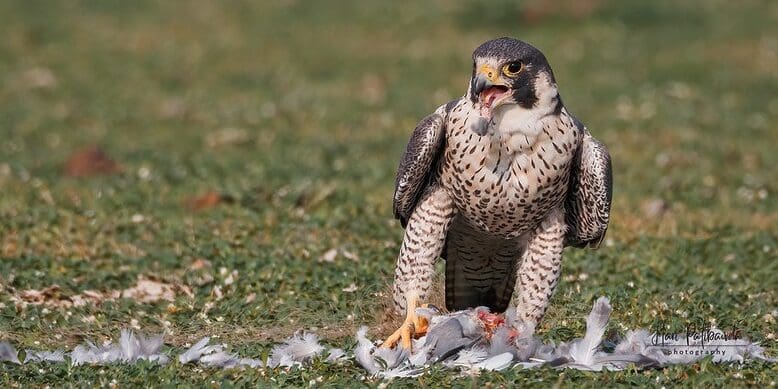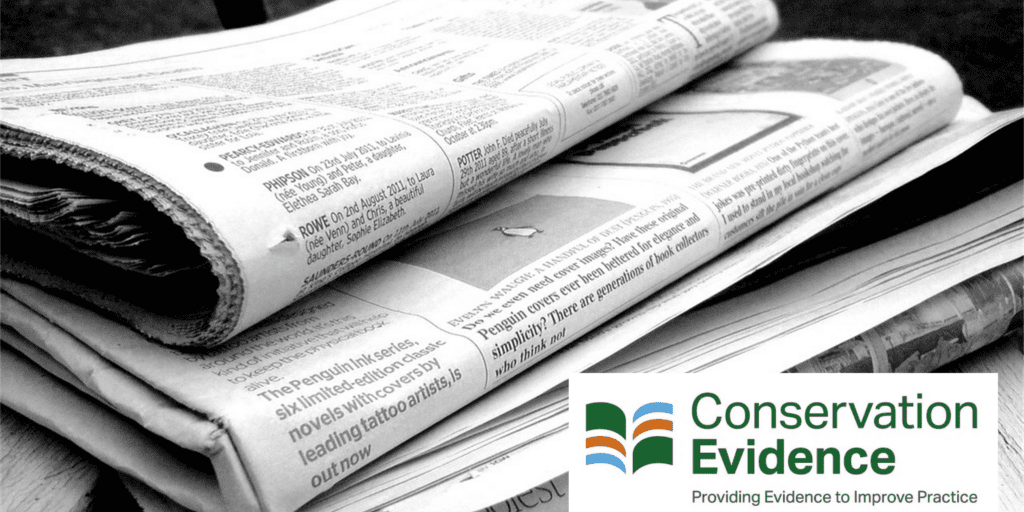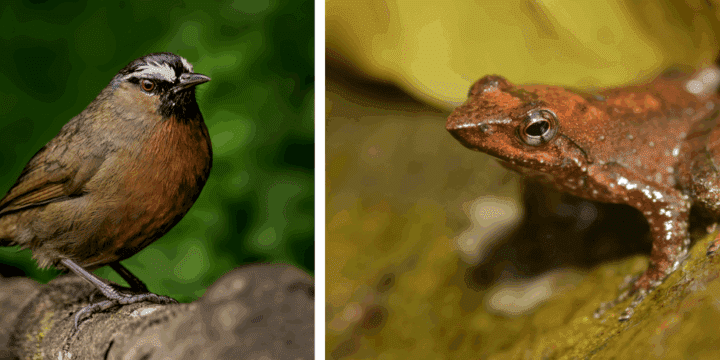Conservation Evidence and invasive species

Here in the UK, this week is Invasive Species Week. We thought this would be a good opportunity to share some of the resources we’ve produced at Conservation Evidence to inform management of invasive species, and conserve species threatened by them.
What are invasive species?
Here, we use the term invasive species to refer to species causing problems for local ecosystems and wildlife [1]. Generally these are also alien species: organisms that humans have introduced to new areas where they wouldn’t naturally be found (although not all aliens are invasive, and native species can be invasive too, but that’s a story for another day).
More than 3,500 invasive alien species, with documented impacts, have been recorded worldwide [1]. They are a major direct driver of biodiversity loss, including global species extinctions [2]. At least 14,744 species are reportedly threatened by invasive species or diseases, with 5,226 species documented as needing invasive species control to improve their conservation status [3]. Invasive species also adversely affect nature’s contributions to people [2], and are associated with massive economic costs [4,5].
Effective and efficient management of invasive species depends on evidence: including on their impacts, pathways and vectors of introduction, and management actions. At Conservation Evidence we focus on the latter.
A recent paper from our group [6] shows that animal species threatened by invasive species are more likely to have worsened in conservation status (compared to species not threatened by invasives). But encouragingly, those with actions to control invasive species are more likely to have increasing populations. Many bird species recoveries have been attributed to invasive species management actions. This includes several island species including Cook’s petrel (Pterodroma cookii), which improved status from Endangered to Vulnerable following huge increases in fledgling success after successful eradication of particularly Pacific rats, alongside earlier eradications of cats and weka [7]
Conservation Evidence Synopses
We currently have one synopsis focused on the effects of invasive or problematic species management actions on the invasive species themselves. We have reviewed evidence for the effectiveness of 161 actions for the control of 12 freshwater invasive species. There 6-22 actions for the control of each species: floating pennywort, water primrose, skunk cabbage, swamp stonecrop, parrot’s feather, Asian clams, ponto-caspian gammarids, procambarus crayfish, brown and black bullheads, ponto-caspian gobies, red-eared terrapins and American bullfrog. Forty-one of the actions were assessed by experts as being “Beneficial” or “Likely to be beneficial”, based on the summarised evidence, one had “Trade-offs between benefits and harms”, 13 were “Unlikely to be beneficial”, and the rest “Unknown effectiveness (limited evidence)” or “No evidence found”. We’re keen to expand/update this synopsis, and add synopses for invasive species control in other habitats.

Most of our other synopses are focused on conservation outcomes for desirable taxa or habitats. But these contain a chapter that synthesizes evidence for the effects of invasive species management on those desirable taxa or habitats, or the effects of conservation actions that can be used to restore species and habitats once invasive species have been controlled.
We have just published a synopsis on Coral Conservation. Invasive species present one of the greatest threats to coral survival. In particular, outbreaks of the notorious crown-of-thorns starfish Acanthaster spp. can devastate coral reefs—a single starfish can consume 10 m2 of coral a year by stripping the living tissue and exposing the coral skeleton. Physically removing crown-of-thorns starfish is tricky, time-consuming, and hazardous. The starfish are venomous, and their spines can deliver toxins that, at the very least, will give you a painful sting and, in some cases, cause liver damage or lead to anaphylactic shock. Divers can remove starfish by using a stick or length of pipe to prise the animal off the reef and take it away to be destroyed. However, this method also risks further damage to the coral. Another approach is to inject starfish with bile salts (digestive juices from gall bladders, usually from cows or sheep) [8]. The bile salts cause tissue damage and a powerful immune response that kills the starfish in ~20 hours [9]. A cheaper option involves injecting starfish with household vinegar which disrupts the internal pH balance, tissues and membranes of the starfish, leading to death [10]. In order to efficiently eradicate the crown-of-thorns starfish from large areas of the Great Barrier Reef, researchers at Queensland University of Technology developed COTSbot—an autonomous underwater robot capable of effectively identifying and targeting the invasive starfish and delivering the lethal injection [9]. Most research to date has quantified the effects of management actions on the starfish, rather than corals: we found only three studies providing quantitative evidence for the effects, on corals, of controlling problematic species.

The Marsh and Swamp Conservation synopsis summarizes studies that measured the effect of problematic species removal on marsh or swamp vegetation. Much of the evidence focuses on control of plant species like common reed Phragmites australis, cattails Typha spp., reed canarygrass Phalaris arundinacea, mimosa Mimosa pigra, and perennial pepperweed Lepidium latifolium. There are numerous studies testing the effect of excluding problematic wild vertebrates (mammals, birds and fish), but fewer on the effects of controlling (e.g. killing) problematic wild vertebrates, and none on managing wild invertebrates. There are some pretty ingenious ways to control problematic species included in the synopsis. In Costa Rica, for example, cattails are controlled by driving over them with paddled tractor wheels. This may have contributed to increases in overall plant species richness. In California, USA, one study tried adding salt to salt marshes to create hypersaline conditions that even salt marsh plants can’t cope with!
Here’s some links to more actions that can be used to conserve various taxa or habitats in the face of threats from IAS: 🐸 Amphibian Conservation, 🦅 Bird Conservation, 🦋 Butterfly and Moth Conservation, 🦎 Reptile Conservation, 🫎 Terrestrial Mammal Conservation, 🌿Shrubland and Heathland Conservation (and many more on the CE website…)
Guidance on invasive species management in salt marshes and tidal flats
Last autumn we launched ‘Restoration, creation and management of salt marshes and tidal flats: a collation of evidence-based guidance’. This was a collaboration with Wetlands International, the World Coastal Forum and global practitioners and advisors. It combines scientific evidence and practitioner experience to give some practical guidance on coastal conservation actions. There are five chapters relevant to IAS management: three on chemical, physical and integrated control of smooth cordgrass Spartina alterniflora, one on managing undesirable vegetation on intertidal flats, and one on managing/clearing vegetation to benefit shorebirds.

Knowledge-sharing platform for invasive species removal projects
We’re currently developing a centralised knowledge sharing platform to record invasive species removal (eradication, control, suppression) projects and their effects. This will help to fill current gaps and deficiencies in the evidence base, ensuring evidence is widely available, in a standardised format, and includes less successful or ‘failed’ removal attempts. Considering the evidence when making decisions about invasive species removal can help us maximise effectiveness and efficiency, and avoid wasting resources on ineffective, or even harmful, projects [11].
We see this new platform as complementary to the Conservation Evidence database: each will capture different information (e.g. socioeconomic outcomes and practical implementation tips in the removal platform, and more detailed quantitative data on effects in Conservation Evidence) but will be clearly cross-referenced.
We held three stakeholder workshops in early 2025, including people from across the globe, and are currently combining all the feedback to develop a data framework that will underpin the knowledge sharing platform. We plan to publish this later in 2025. With further funding, over the next year or two, we’ll start to populate the database and develop a user interface so that you can record your own invasive species removal projects!

References
[1] Roy H. et al. (2023) Thematic Assessment Report on Invasive Alien Species and their Control of the Intergovernmental Science-Policy Platform on Biodiversity and Ecosystem Services. IPBES secretariat, Bonn, Germany. https://doi.org/10.5281/zenodo.7430682
[2] Bacher S. et al. (2023) Chapter 4: Impacts of invasive alien species on nature, nature’s contributions to people, and good quality of life. In: Thematic Assessment Report on Invasive Alien Species and their Control of the Intergovernmental Science-Policy Platform on Biodiversity and Ecosystem Services. IPBES secretariat, Bonn, Germany. https://doi.org/10.5281/zenodo.7430731
[3] IUCN (2025) IUCN Red List of Threatened Species version 2025.1. https://www.iucnredlist.org/
[4] Diagne C. et al. (2021) High and rising economic costs of biological invasions worldwide. Nature, 592, 571–576. https://doi.org/10.1038/s41586-021-03405-6
[5] Turbelin A.J. et al. (2023) Biological invasions are as costly as natural hazards. Perspectives in Ecology and Conservation, 21, 143–150. https://doi.org/10.1016/j.pecon.2023.03.002
[6] Simkins A.T. et al. (2025) Past conservation efforts reveal which actions lead to positive outcomes for species. PLoS Biology, 23, p.e3003051. https://doi.org/10.1371/journal.pbio.3003051
[7] BirdLife International (2018) Pterodroma cookii. The IUCN Red List of Threatened Species 2018: e.T22697975A132616449. https://dx.doi.org/10.2305/IUCN.UK.2018-2.RLTS.T22697975A132616449.en. Accessed on 07 May 2025.
[8] Rivera-Posada J. et al. (2015) Bile salts and the single-shot lethal injection method for killing crown-of-thorns sea stars (Acanthaster planci). Ocean & Coastal Management, 102, 383–390. https://doi.org/10.1016/j.ocecoaman.2014.08.014
[9] Platt J.R. (2016) A starfish-killing, artificially intelligent robot is set to patrol the Great Barrier Reef. Scientific American. https://www.scientificamerican.com/article/a-starfish-killing-artificially-intelligent-robot-is-set-to-patrol-the-great-barrier-reef/
[10] Boström-Einarsson L. et al. (2018) Environmental impact monitoring of household vinegar-injections to cull crown-of-thorns starfish, Acanthaster spp. Ocean & Coastal Management, 155, 83–89. https://doi.org/10.1016/j.ocecoaman.2018.01.023
[11] Caruana A. et al. (2024) Mechanical excavation of wetland habitat failed to eradicate invasive American red swamp crayfish (Procambarus clarkii) in Malta. Ecological Solutions and Evidence, 5, e12325. https://doi.org/10.1002/2688-8319.12325



